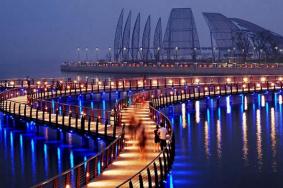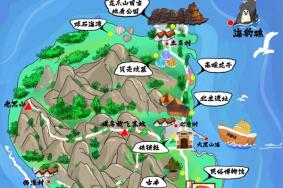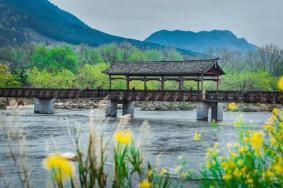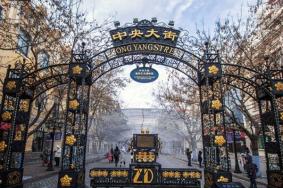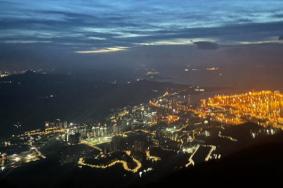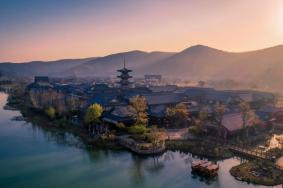导读:用英文介绍一下天津 一、用英文介绍一下天津 二、急需天津市景点英文导游词~~ 三、用英文简单介绍一下天津的古文化街
一、用英文介绍一下天津
Tianjin simply known as Jin is situated in the northeastern part of North China Great Plain, bordering the Bohai Sea in the east, leaning against the Yuanshan Mountain in the north, with its terrain traversing the Haihe River through north and south. It has become the hub of communications of North China and the gateway of the capital city.
Tianjin is a municipality direct under the Central Government, as well as an opening city. It's situated in the eastern part of the North China Plain, covering an area of 11,300 square km. and with a population of six million.
It has a semi-humid continental climate in the warm Temperate Zone. With an annual average temperature of 12 degrees centigrade, and rainfall of 590 millimeters, it has 220 frost-free days per year. It's rich in petroleum, natural gas and sea salt along the coastal area.
As one of China's biggest industrial centers, Tianjin has built up an all-round industrial system with machinery, electronics, textiles, chemicals, metallurgy, foodstuff etc. as its mainstays. The production on a fairly large scale, of arts and crafts like hand-made carpets, Yangliuqing's New Year Pictures printed from an engraved wood plate, Zhang's painted clay figurines, kites etc. holds an important position in the country. Tianjin has already achieved successes in the operation of its Economic and Technological Development Zone in the northeastern part of Tanggu District, covering an area of 33 square km.
Tianjin is one of the most prosperous business areas as well as a distribution center for goods and materials in North China.
It's also a key hub of land and sea communications. Its port consisting of Tianjin, Tanggu and Xingang Harbours is an important Chinese Sea port, serving as the most convenient sea outlet for Beijing, North China and Northwest. The port accessible to ocean freighters of ten thousand tons class has opened more than 20 ocean shipping routes. Tianjin has a well-developed road transport network, regular air-service to over 30 cities throughout the country, and inland water shipping, in addition to the pipelines for oil transport.
Tianjin is a famous historical city. The best known scenic spots and historical sites include Ning Garden, Tianhou Temple (Temple of Heavenly Empress), Dule Temple in Ji county, The Great Wall at the Huangya Pass, the Panshan scenery area etc.
Efforts are being made to develop Tianjin primarily into a financial center in North China, an international commercial city and a free port.
shoucang
二、急需天津市景点英文导游词~~
Tianjin is a good choice as a travel destination. With its cool sea breeze and fresh sea air you will definitely feel refreshed. Historical relics, natural scenery, temples, churches, assembly halls and commemorative sites of the Chinese revolution will illuminate Tianjin's past, present and future. Tianjin is honored as 'Building Museum' as it was occupied by nine imperial powers before the founding of the new China, leaving behind many buildings with extraordinary and exotic architectural styles, a real feast for the eye! In the following text let me give you a brief introduction to the Jinmen Shijing (top ten scenic attractions in Tianjin).
Huangyaguan Great Wall :
Located in the mountainous area of Tianjin's northern Ji County, the Huangyaguan Great Wall was first built during the Northern Qi Dynasty (550 - 557) and repaired in large scale with bricks during the Ming Dynasty (1368 - 1644). When appointed as the chief commanding officer in the Ji Garrison (one of the eleven garrisons of the Ming Dynasty), Qi Jiguang added watch towers and other defensive works.
The Huangyaguan Great Wall comes out first in the ten most-visited sites in Tianjin. It is considered to be a miniature of the Great Wall. The entire section is built on an abrupt mountain ridge. Being endowed with both natural beauty and cultural interest, it has become famous as a natural b eauty spot and a summer resort. The major scenic area is composed of Huangyaguan Pass and Taiping Mountain Stronghold.
Huangyaguan Pass: In 1984, the people of Tianjin spent three years repairing 3,308 yards of the main wall from Banlagang Mountain in the east to Wangmaoding Mountain in the west. They restored 20 terraces, the Huangyaguan Water Gate, and the Bagua Castle (the Eight Diagrams Castle). The defensive system of the wall is complete. Watch towers, frontier cities, drain holes, emplacements, barracks and other indispensable military facilities are arranged orderly along the wall. Besides, the stele forests of the Great Wall, Beiji Temple, the exhibition hall of famous couplets, the Great Wall Museum (the first museum along the Great Wall) and the Phoenix Fortress have been newly built within the area.
Taipingzhai Great Wall :
Six miles southeast of Huangyaguan Pass is the Taipingzhai Great Wall, another important mountain stronghold of the wall during the Ming Dynasty (1368 - 1644). It is also called Taipinganzhai, meaning a village of peace and prosperity. Starting from Banlagang Mountain in the east and arriving at Guafu Tower (Widow Tower) in the west, it winds through the precipitous mountains for about 955 yards.
The wall is an important component of Huangyaguan Great Wall. There are six watch towers, one battlement, and one shortcut leading to the wall. The architectural styles of the military towers vary considerably. There are square, round, solid and hollow towers, with some inside and others outside the wall. Beside the shortcut, there is a small citadel where an 8.5-meter statue of Qi Jiguang, the chief commanding officer of Ji Garrison (one of the eleven garrisons in the Ming Dynasty) is located. The local people built this statue in order to commemorate his great contribution to frontier peace and stability in that period. To the west of the citadel, a section of the wall extends 33 yards out to where a sentry post was situated.
At the western end of the wall is a square stone tower called Guafu Tower, Widow Tower in English, built by twelve wives whose husbands died during the construction of the wall in the Ming Dynasty. The widows erected this tower to commemorate their husbands' notable exploits. The tower has two levels and measures 13-meters (14-yards) high. Arched arrow windows are on the four sides of the tower.
Besides these cultural points of interest, Taipingzhai Great Wall is also famous for its amazingly impressive scenery. Zigzagging along the mountain ridge for over 984 yards, the wall looks very much like a giant dragon flying through clouds.
Mt. Panshan Scenic Area :
Covering an area of 106 square kilometers (about 26193 acres), Mt. Panshan Scenic Area is located in Jixian County, 110 kilometers (68.4 miles) away from Tianjin, 88 kilometers (54.7 miles) away from Beijing. As the name suggests, the scenic area is mainly Mt PanshanCoriented. Endowed with natural beauty and a historical heritage, Mt Panshan is known as 'The First Mountain East of Beijing' and is listed as one of the top fifteen mountains in China.
The mountain acquired its present name, early in the Eastern Han (25-220). Taizong , the second emperor of the Tang Dynasty (618-907), was prodigal of his praise of its scenery on his chance visit when he led the army in a campaign. Seventy-two temples, thirteen pagodas and numerous Xanadus and towers were built on the mountain in the Ming Dynasty (1368-1644) and the Qing Dynasty (1644-1911). Qianlong, a brilliant and wise Qing Dynasty emperor was so impressed that he made thirty or so visits and wrote 1366 poems to express his admiration of the area. In the first half of the twentieth century, the whole resort all fell to ruin due to hostilities and neglect. It has undergone a process of restoration since the 1990s and is now regaining its fame.
It is famous for jade pine trees, strange and astonishing peaks, clear waters, grotesquely shaped rocks and clusters of ancient temples. On the mountaintop, numerous pin es hide the sky from view and block out the sunshine. Rugged rocks in a variety of shapes, some of which resemble a toad, a general or a boa, will greet you in the middle of the mountain. At its foot, clear water splashes on the rocks. The mountain consists of five peaks, with the main one, Guayue (Moon Hanging) Peak. Although Guayue Peak is only 857 meters (2811.7 feet) above sea level, to the north it is possible to see a section of the Great Wall while to the west Mt Taihang can be seen.
From the Wei State during the Three Kingdoms Period (220-280) onwards, emperors enthusiastically commissioned the building of temples, towers and Xanadus resulting in over 160 such sites. There are four main temples: Tiancheng Temple (God Proposing Temple), Yunzhao Temple (Cloud-Hiding Temple), Wanfo Temple (Ten Thousand-Buddha Temple) and Wansong Temple (Ten Thousand-Pine Temple). Tiancheng Temple built in the Tang Dynasty, was enlarged and repaired in the Ming and the Qing dynasties. To the east of this temple stands the Ancient Dagoba. As the biggest tower in this mountain, it has thirteen floors. The roof of the Yunzhao Temple was a golden yellow, a color that normally was only allowed to be used on imperial buildings. By granting permission for this, Emperor Qianlong demonstrated his approval and admiration of the mountain. Wanfo Temple (Ten Thousand-Buddha Temple) has 10,960 small Buddhas statues.
天津光华导游培训,提供了10篇导游词。还有英语的10篇,包括天津滨江道劝业场英文介绍(英文导游词)。英文双语班的通过率是80%以上!特别高!你可以问问,他们还提供专门的英语口语集训,面授,很便宜的
三、用英文简单介绍一下天津的古文化街
Ancient Cultural Street
The 580-metre-long Ancient Cultural Street is a major tourist destination where Tianjin's old traditions remain largely intact. Imitation Qing buildings, which house nearly 100 shops are scattered along the street with the Tianhou Temple in the center. Built in 1320 during the Yuan, the Tianhou (Heavenly Queen) Temple, also known as Temple of the Patron Goddess, is one of many temples established in China's coastal areas in honour of the mythological angel known more popularly as Mazu. Grand sacrificial ceremonies were held in the temple on Mazu's birthday, which fell on the 23rd day of the 3rd lunar month. Today the temple has been converted into the Tianjin Folklore Museum.
本文部分来源于网络,并不意味本站赞同其观点,文章内容仅供参考;此文如侵犯到您的合法权益,请联系我们处理;
本文永久链接:https://www.yzihan.com/ctrip/5722.html


